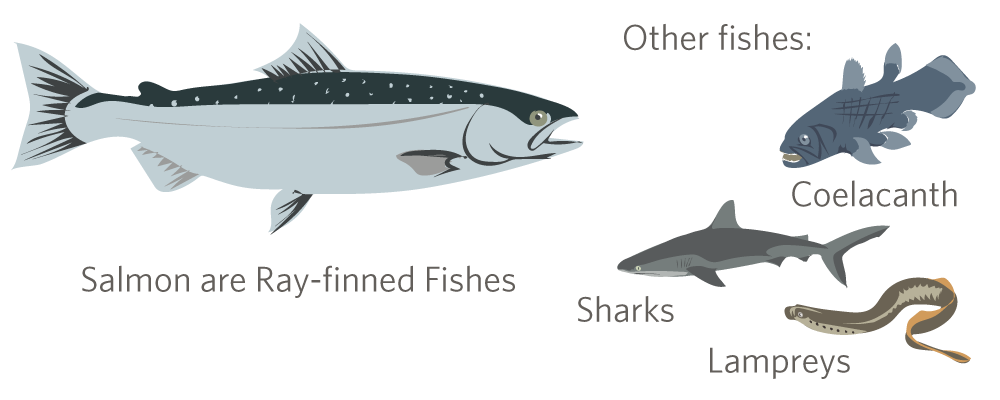Its Fish Week on iNaturalist! Feb 21 - 27, 2016

This week for the Critter Calendar we’re challenging you to find some of the most plentiful vertebrates in the world...yet less than 2% of all observations on iNaturalist are members of this class - they’re the Actinopterygii, or Ray-finned fishes!
OK, close your eyes and picture a fish. Odds are you were thinking of a ray-finned fish. They make up more than 99% of all 30,000 described fish species and are found in oceans, streams, lakes, rivers and pretty much any other freshwater or marine environment you can think of. While they come in many shapes and sizes, ray-finned fishes all possess fins which are made of membranes of skin supported by bony or horny spines. Fish that do not belong to the Actinopterygii include the lobe-finned fishes, like the coelacanth, or the cartilaginous fishes, which includes the sharks and rays.

Fins themselves lack muscles, but are attached to muscles in the fish’s body and are used mainly for locomotion. Each fin has its own use. Caudal, or tail fins, are used for propulsion, while dorsal fins, which are found on the “back” of the fish help maintain stability.


The large dorsal fin of the Sailfish is raised when the fish is excited or threatened, making it seem larger than it really is. Sailfish will also use it to “herd” prey.

Pectoral fins, which are located on the side of the body, aid in steering, balancing and braking. The greatly enlarged pectoral fins of Flying Fish are even used for gliding in the air, a maneuver that helps them evade predators.

Most fish use their pelvic fins (found on the ventral side) for going up and down in the water, as well as for making quick stops. Gobies have evolved fused pelvic fins that form a suction cup, which they use to attach to rocks and other objects. The “Inching Climber” goby (Sicyopterus stimpsoni) of Hawaii even uses this suction cup to help it climb up waterfalls!

Some fish use their fin-rays not just for locomotion but for defense. Lionfish and stonefish deliver painful and sometimes deadly venomous stings through their fin-rays. Originally found in the Indo-Pacific regions, Lionfish have been introduced to the Atlantic Ocean and Caribbean Sea, where they are considered invasive organisms.
So head to the watery parts of the world (apologies to H. Melville) and find some fIsh! Check out a pond or stream, explore some tidepools, perhaps even do a little fishing - we want your ray-finned fish observations! We’ll be keeping track of them here.





Comentarios
ARGH - I just spent 20 days diving in Mozambique, ended yesterday!!! Game over for me :-(((((
Last day in Maui, invited to a birthday party on the beach. Water lookes horrible from the wind. This is my only chance to find some fish on fish week though. So I grab my mask and head into the surf.
I swim more through the surf. Ugh, this isn't getting any better. When will I get far enough past the breakers for it to be calm?
Wait, that is a rock, I can finally see bottom! Time to make sure I find some fish for fish week!
Man, without fins, it is really hard to get down!
Woah, how did that sea turtle sneak within three feet of me! Guess the ten foot visibility partiality explains that.
Hey, a fish! Take a whole bunch of photos quickly since the GoPro misses most shots!
Ten more minutes of splashing around for a couple blurry photos.
OK, I am getting sea sick time to go in.
Hey, a sea urchin right below me! Quick take a picture! Uh oh, that got really close when the wave crashed over me.
Perhaps I should have paid more attention to where I was coming to shore, there are rocks everywhere. Oh well, it looks too hard to go out farther, I will try to sneak between them.
Yikes! The rock hit me! Ok, no sea urchin spines, I got lucky!
Made it home without even a cut. Still, I think duck week was safer.
Ha! I had flahsbacks reading this @glmory, pretty much describes my GoPro mostly fail snorkeling adventures in Hawaii last May. So were you victorious? I plan on poking my GoPro into the Russian River on Wednesday which has the potential to produce steelhead obs but will probably more likely produce a wet, cold, pseudo-dangerous experience like you just described.
I won't be certain until I get home and sort through some of my 10,000 or so Maui photos. There must be at least a few identifiable fish from today, but none will be pretty.
The problem is largely the GoPro. It just isn't made for fish pictures. I should have bought something like an Olympus TG-4 which does better macro. Next month I get a Sony a6300 which will slowly be turned into an underwater camera. That might not get me to Maractwin's level, but should be a big step up.
It really helps to use something with a flash. Otherwise colors aren't true and the shutter speed ends up too slow to freeze the action. The more problems I have with airlines and my 60 pounds of photo gear, the more I'm tempted to go back to a little point-and-shoot.
I am slowly working my way up to a mirrorless camera underwater setup. It seemed like a good compromise between size and performance.
It will probably be another year before it is ready to go though. Getting the camera and a macro lens within the month, then a housing and flashes in a year or so.
Añade un comentario